Age of Mythology Showcase: Thor
This month, we profile the mighty son of Odin. Take a look at Thor and the Norse culture.
Age of Mythology has now been in development for over a year, and as the game speeds steadily toward its release in September 2002, we are receiving more information about this eagerly anticipated leap forward in the Age series. Thus far, our ongoing Age of Mythology showcase has unveiled two prime examples of the Greek and Egyptian cultures, the Zeus and Ra factions, respectively. This month, we're doing something a bit unusual. Whereas the prior showcases were fronted by the heads of each culture's pantheon, this month we will not be delving into the secrets of Odin, as the pattern might indicate. Instead, we're looking at his son, the god of thunder and the most heroic of Norse deities: the mighty Thor.
The Norse culture in Age of Mythology is very different from the Greeks or Egyptians, and the greatest departure among the three from the gameplay of Age of Empires. Of course, they have unique units, mythological creatures, god powers, and improvements. But that's to be expected. What's more surprising is that they actually gather resources and build structures a little differently. The way in which they earn favor is also a big change from the other cultures. The Norse's theme is one of expansion and aggression. And much of their gameplay style, from units to infrastructure to favor gathering, is geared toward overrunning the map with units and staking claim to territory with rapidly expanding buildings.
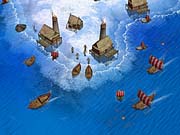
As the Age of Mythology Norse culture stands in contrast to the more familiar Greek culture, so too does its mythology historically stand apart from Greek mythology. Greg Street, designer of Age of Empires II, says, "Perhaps it is not surprising that the mythology of a people native to the cold, hard land of Scandinavia would be bleak, bleak, bleak. There are giants as foes of the gods in Greek and Egyptian mythology, but in Norse mythology it was common knowledge that the gods would eventually have a final battle with the giants, in the Armageddon-like "Ragnarok," and even the gods would not survive it. Whereas Zeus was capricious and moody, Odin, the ruler of the Norse gods, could be downright malevolent, even to his own worshippers. While Hades could be dreary at parties, Loki, the Norse god of mischief, sired horrible monsters that bit off the hands of other gods. The gods had to sacrifice their own eyes or chain themselves to trees in order to gain wisdom."
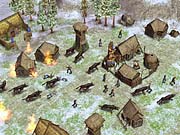
Yet, providing support for the beleaguered Norse Viking of ancient times was Thor, a "god of the people," as Street explains: "While the Norse made contributions to culture just as the Greeks and Egyptians did, it's the longboats and Viking raiders that everyone remembers of them. Fortunately, the Norse had a powerful ally in Thor. Thor was a blue-collar god, the protector of the common man. While Odin was the patron of wealthy rulers, devious nobles, and career politicians, Thor was looking out for the poor muddy schmuck with a spear riding in the back of the longboat. Thor's the kind of god you can drink mead with. Thor solves problems with his hammer instead of his noggin. There are no hidden agendas with Thor--what you see (big red-haired guy with a big hammer in goat-drawn chariot) is what you get."
But to understand exactly "what you get" with Thor in Age of Mythology, we need to first take a look at the differences in gameplay for the Norse culture.
Norse Play
Age of Empires veterans might be confused the first time they play a Norse culture. For starters, Norse villagers do not build. All they do is gather resources. That's why they're called gatherers. Instead, infantry units actually build the Norse buildings. Street elaborates, "Any Norse infantry unit can build. This has some amazing gameplay ramifications: Norse towns tend to sprawl across the map because a scouting ulfsark will just drop houses wherever he is exploring. Norse players are forward builders par excellence. Norse are great at claiming settlements because as soon as they knock down an [enemy] town center, the same units can build a new one in its place."
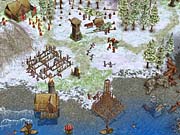
The Norse gatherers also get a huge leg up on their competition in resource gathering with the ox cart, a mobile drop site for food, wood, and gold. The Norse do not need to build any resource buildings, like lumber or mining camps. Instead they get one unified drop site, and it can move (they can, of course, still drop off resources at the town center). The ox cart is a unit that you build from the town center, and as a unit, it can move and follow your gatherers. Thus, as you clear out one gold mine, you can move your ox cart and villagers to the next one, while the Greek and Egyptian players have to build new mining camps. Says Street, "[The ox cart] lets the Norse play as nomads, and it lets them rebuild quickly when their buildings collapse, which seems to happen all the time, as Norse buildings are cheap and fragile."
Because their gatherers can't build, the Norse start out with an infantry unit. In fact, the Norse player begins with a seeming advantage: two gatherers, an ox cart, and an ulfsark, the basic Norse infantry unit. Street explains, "The initial ulfsark is needed to build houses, walls, and the temple, but it also serves as the Norse scout. He is much slower than the Greek scout cavalry, and he is needed to build, so like the Egyptians, Norse aren't so good at early exploration."
A Norse player who loses his or her infantry is effectively dead, so the civ's most basic infantry, the ulfsark, can be trained from nearly anywhere, including the town center and the Norse barracks, the longhouse. Street even indicated that you can train them from some ships or through a god power. Of course, this means that from the very start of a game the Norse player can crank out infantry units and start an ulfsark rush. But not to worry, says Street, "While all this focus on rushing might make the Norse seem one-sided, the reality is quite different. Norse towns don't have great building defenses, but they do have lots of infantry units around their buildings. Egyptian cities by contrast are pretty soft on the inside. The Norse ability to rebuild and move their drop sites makes them viral--you knock down one city, only to have them spring up in two more places on the map."
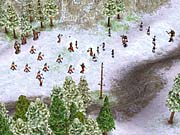
We mentioned earlier that the Norse also gain favor a little differently than the Greeks or Egyptians. Norse don't pray to gods or build monuments. Instead, Norse gain favor by fighting. Every time Norse units battle and slay enemy units, the Norse player gets a little favor. If you fight a huge, pitched battle and rack up a tremendous number of kills, you get lots of favor. If you avoid confrontation, the Norse gods will reward your cowardice with zero favor. This mechanic forces the Norse player into conflict early and often. As we said, the Norse culture is designed for naked aggression, and by tying their favor gathering to their prowess in battle, the designers at Age of Mythology are guaranteeing that the successful Norse player is the one who is always on the offensive.
Thor and His Dwarfs
The Norse's ox carts, building infantry, gathering villagers, and unique manner of gaining favor already set them far apart from their Age of Mythology counterparts. But there is yet another feature unique to the Norse, and, coincidentally, this unique feature is also one of Thor's biggest advantages. Unlike the Greeks or Egyptians, the Norse have a secondary gathering unit: the dwarf.
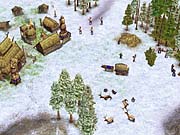
Greg Street provides a little background: "In mythology, Thor had a special relationship with dwarfs." These dwarfs, though, aren't the good-hearted diggers from Snow White or The Lord of the Rings. "The dwarfs of Norse mythology were the offspring of maggots," Street says. "Unlike the dwarfs of fantasy, which were based on the original Norse dwarfs, those of mythology tend to be greedier and are more capable of using magic. Dwarfs forged many of the magic weapons used by the Norse gods, including Thor's hammer, Mjolnir (they made the haft of the hammer too short, which is why Thor is usually depicted wearing gloves.)"
All three Norse gods--Thor, Odin, and Loki--can train dwarfs at their town centers. They cost gold to build instead of food, and they cannot build structures. What they're really good at is harvesting gold. They gather gold faster than a Norse gatherer or any other culture's villager. To compensate for this advantage, they're awfully slow at gathering the other two resources, food and wood. You can make them do it, but they aren't good at it. The smart Norse player will thus crank out a few dwarfs to mine gold, while keeping his human gatherers on wood and food duty, increasing his overall economy more quickly than a Greek or Egyptian player.
Thor, though, thanks to his friendship with the dwarfs, can get even better work out of them. Street explains: "Thor has a slight advantage, however, in that his dwarfs aren't terrible at food and wood gathering (though they are still worse than human gatherers). As a result, Thor can just get by with training mostly dwarfs to serve as villagers, which has unusual gameplay ramifications, as the player can focus on gold early instead of food."
Another one of Thor's advantages also involves dwarfs: the dwarf foundry. In Age of Mythology, upgrades to your mortal units, such as infantry, cavalry, and archers, are found at the armory, which is built in the Classical (second) Age. "Thor, however," Street says, "has a dwarf foundry instead of an armory. The foundry can be built in the Archaic [first] Age, and all the improvements therein can be researched in the first age. Of course, the expensive price tag on iron weapons may present a problem until later in the game. In addition, Thor has three special armory improvements not available to other major gods. The upgrade from iron mail is meteoric iron mail. The upgrade from iron shields is dragonscale shields. The upgrade from iron weapons is called hammer of the gods. All these improvements can make Thor's soldiers even mightier (more resistance to hack attacks, more resistance to pierce attacks, and more attack power, respectively) in combat."
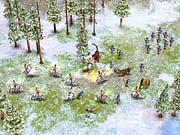
Thus far, we've outlined two of Thor's faction bonuses: His dwarfs work faster than the dwarfs of other Norse gods, and he builds the dwarf foundry instead of the armory. The foundry in turn gives him earlier access to military improvements and access to three unique technologies. Thor's third advantage, though, is all about war.
Thor's Longhouse and Mighty Infantry
Thor, as stated previously, is the patron of the common soldier, the inspiration for the battle-hungry Norse infantry. It is only natural, then, that one of his bonuses centers on the longhouse, where the basic infantry units of the Norse are trained. Says Street, "Thor focuses on the rank-and-file soldiers from the longhouse, not all those greedy, mamby-pamby elite units counting gold up in their high-and-mighty hill fort." Units produced at the longhouse already train faster than the units produced at the barracks of other civs, but Thor's bonus enables his longhouse units to train even faster than those of the other two Norse gods. The units built at the longhouse are the ulfsarks, throwing axemen, raiding cavalry, and the hersir, who are in fact the Norse heroes.
So what do these infantry units do, exactly? The ulfsark is a spearman. According to Ensemble, it is "a general-purpose unit good at stopping cavalry." Street adds this bit of trivia: "They are named for the wolf pelts they wore into combat ('ulf' is Norse for 'wolf'). Incidentally, 'berserk' is derived from 'bjÓrn serkr,' or 'bear shirt,' as berserkers wore bear pelts into combat. Compared with a Greek hoplite or Egyptian spearman, the Norse ulfsark is unarmored but [has] a huge attack."
Throwing axemen serve a very important purpose for the Norse, because they have no archery units. Instead, throwing axemen provide ranged support for the Norse armies and are used to counter infantry, much as normal archers are. As noted by Greg Street, "Norse versus Norse games have a lot of throwing axemen." Raiding cavalry are used mainly to counter enemy archers, because they are cheap to build and very fast.
All Age of Mythology cultures have a hero unit. The Greeks have named heroic figures, while the Egyptians have the pharaoh and his priests. The Norse heroes are fighters, and they are cheaper and more plentiful. But don't think that they are super units. Just because you can mass-produce Norse heroes (something you can't do with the Greeks or Egyptians) doesn't mean you'll always win by fielding hordes of hersirs. When we played a few games with the Age of Mythology beta a few months ago, we tried this route, and we often lost to more balanced armies that featured myth units, strong mortal units, and heroes. Hersirs are strong, but they have a specialized purpose. Street explains: "The hersir is what Norse use to fight myth units and to gain favor. While any Norse generates favor while fighting, the hersir gain favor at a faster rate. Thus a Norse player who wants to train myth units or pursue myth techs must make a commitment in training heroes, much as the Greeks or Egyptians would."
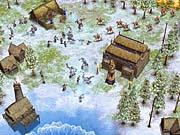
Aside from being the bulk of your army and the main source of generating favor, your longhouse units are also your primary architects. "Since the ulfsark, throwing axeman, and hersir are all infantry," Street says, "they can all build buildings, from houses to towers to longhouses to town centers or even wonders. The longhouse also has improvements for the military, much as the Greek academy and Egyptian barracks do. The medium, heavy, and champion infantry and cavalry improvements are in the longhouse (Norse have no archers, remember), as are the levy and conscript infantry and cavalry improvements that let those soldiers be trained even faster in later ages." These latter improvements simply add to Thor's strength, giving him even faster infantry unit production. Add in the dwarf foundry improvements that are unique to Thor, and you can quickly see that this faction will be the perfect match for players who want overwhelmingly powerful and numerous melee forces.
Minor Gods and Myth Units
As you advance from the Archaic Age to the Classical, Heroic, and finally Mythic Ages, you find some interesting options for the worshipper of Thor. At each age advancement, you can choose between two gods, earning new mythological units, technologies, and god powers, depending on your choice.
In the second age, one such minor god is Forseti. Street says, "Forseti was the Norse god of justice and was known for his glittering hall of silver and gold (the Norse gods were all big on having gigantic halls). Forseti's improvements generally aid infantry, such as the mithril breastplate, which improves infantry armor, and the hall of thanes, which improves the combat abilities of the hersir. Forseti's myth unit is the troll, another creature from Norse mythology that has been virtually co-opted by medieval fantasy. The Age of Mythology troll is a rare Norse archer. He is a good unit to spring on enemies because Norse opponents usually don't invest in shield upgrades since they expect Norse will rarely attack with archers. Forseti's hamarrtroll improvement makes the trolls more dangerous in combat and gives them an extra head." The troll's ranged capabilities already make it a desirable support unit for the Norse, but it will also have a special ability, as nearly all myth units do. At this point, Ensemble isn't sure what that special ability will be, but it could involve poison arrows that cause damage over time to targets.
When advancing to the third age, a Thor player can choose between Bragi or Skadi. Bragi, god of wisdom and son of Odin, is a good choice for those Thor players who want to improve their already strong ulfsarks. However, Skadi, the goddess of hunting and winter, gives Thor other interesting options. Street says, "While [Skadi] was generally on the side of Odin and Thor against Loki, she was not to be trifled with. [She was] known for her harsh judgment and punishment. Skadi also focuses on improving infantry, but particularly throwing axemen. Her huntress' axe myth improvement increases the throwing axeman's attack. Skadi's winter harvest improvement is one of the relatively few economic Norse myth techs, and it benefits farms. As the mistress of winter, Skadi has the frost giant myth unit and the frost god power. The frost giant is a lumbering hulk with hundreds of hit points. He freezes units with his icy breath before shattering them with icy fists."
The final choice for the Thor player comes in the Mythic Age. Actually, because Loki has a unique minor god all to his own, Odin and Thor both share the same choices upon advancing to the final age. (It's unusual for a major god such as Loki to have a unique minor god, but as with Zeus and Hera, it does occur, albeit infrequently.) In any case, the choices open to Thor are Baldr, the god of beauty, or Tyr, the god of war. "Tyr again benefits infantry," Street says, "making the Forseti-Skadi-Tyr choice popular among Thor players who want to have great infantry at the expense of other unit lines. Tyr's berserkergang myth improvement is expensive but increases the hit points of infantry units at a time in the game when the Norse attack starts to slip off against the high hit points of the Greek hoplites." In an ironic twist, Tyr's greatest enemy also provides him with his sponsored mythological unit. Street explains, "One of Loki's aforementioned monster children was the hideous Fenris Wolf, which actually bit off the hand of Tyr. As payback, Tyr can train the fenris brood, the offspring of the original Fenris." Each fenris wolf is cheap and weak, as far as myth units go. However, they aren't meant to attack individually, but in packs, just like real wolves. Thus, you will want to crank out five or six of them and have them attack en masse. The more wolves you have in a pack, the stronger and faster each individual wolf becomes. While a single giant will still do as much damage as a pack of fenris wolves, the wolves will enjoy greater numbers and much better speed.
God Powers
God Powers are one major reason to choose one particular god over another as you advance through the ages in Age of Mythology. And from what we've seen so far, the Norse gods quite possibly have some of the best god powers in the game. We can't divulge all of them yet, but suffice it to say that the Norse god powers can achieve some spectacular results that put Zeus' lightning bolt to shame. The two god powers we can discuss belong to Skadi and Tyr.
Skadi's god power, frost, is appropriate to her sphere of influence as the goddess of winter. Greg Street explains: "Frost works much like the breath attack of the frost giant, but covers a much larger area. It will render an attacking army immobile for about a minute or so and affects a relatively large area (nearly a screen). While this might seem to make frost a god power that lets you win any battle, the ice on the frozen units contributes to their armor, which makes them harder to kill. As such, Frost is more useful as a delaying tactic, to flee from combat or even buy time to train more units or wait for the arrival of allied cavalry. Remember, Norse strength lies in numbers of units more than the strength of individual units. Because Thor trains units quickly, a minute of time can be all he needs to prepare for an enemy invasion. Of course frost can be used offensively as well just before a big attack on an enemy city."
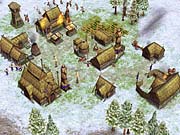
Tyr's god power, ragnarok, is a tremendous one that befits its status as a fourth age ability. "Ragnarok, Tyr's god power," Street says, "can be very powerful when used correctly. It turns all gatherers and dwarfs instantly, at no cost, into Norse heroes [hersirs]. Using this god power is a gamble, because it means temporarily sacrificing your economy in order to convert perhaps 30-40 villagers into an instant army. A Thor player who is caught without any ulfsarks, has just completed a wonder, or just wants to put the nail into an enemy coffin can easily leverage this god power into an army of 100-plus units depending on how many town centers he has. While many of the fourth age god powers have a limited duration, Ragnarok is a longer-term investment. It is instantaneous and permanent. You just have to remember to make some more villagers unless you really do intend for this to be the 'final battle' of the god power's namesake."
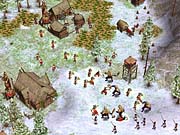
What we've seen of the Norse has left us very impressed with their innovative design and their fun and aggressive gameplay style. And Thor just emphasizes the uniqueness of the Norse civ. But he isn't even the best of the gods. In fact, as we turn back to the Greeks for our next showcase, you'll see that the different major gods are indeed far removed from each other in terms of advantages and abilities. Greg Street provides the perfect prelude to next month's unveiling: "Think you know all there is to know [about Greeks] from the Zeus showcase? Poseidon has some tricks of his own. Remember, he was not just the god of the sea, but also of commerce and horses."
Next month, we tackle the second major Greek god: Poseidon.
Got a news tip or want to contact us directly? Email news@gamespot.com
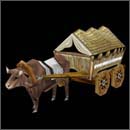
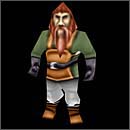
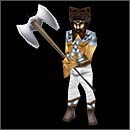
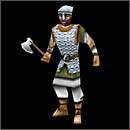
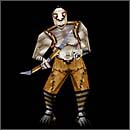
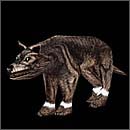
Join the conversation